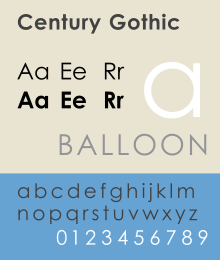Century Gothic
 |
|
| Category | Sans-serif |
|---|---|
| Classification | Geometric |
| Foundry | Monotype |
| Date created | 1991 |
| Design based on | Twentieth Century |
Century Gothic is a sans-serif typeface in the geometric style, released by Monotype Imaging in 1991. It is strongly influenced by the font Futura, though with a higher x-height, and its design history also derives from two separate typefaces intended as Futura competitors. It is a digital typeface that has never been made into actual foundry type.
Like many geometric sans-serifs, Century Gothic's design has a single-story "a" and "g", and an "M" with slanting sides resembling an upturned "W". Century Gothic has a high x-height (tall lower-case characters). Its origins (see below) come from a design intended for large-print uses such as headings and signs, and so it has a reasonably purely geometric design closely based on the circle and square, with less variation in stroke width than fonts designed for small sizes tend to show, and a relatively slender design in its default weight. Its default spacing is quite tight in the style popular in American post-war display typefaces. Characters are quite wide; Monotype have described it as a "spacious" design.
While many geometric sans-serif typefaces have been released to compete with the popular typeface Futura, Century Gothic is perhaps unique in its origin: it redraws one to match the design proportions of a second. Century Gothic was created to be a substitute font for ITC Avant Garde, designed by Herb Lubalin, and released by the International Typeface Corporation (ITC) in 1970, so a document created in one can be displayed in the other with no change to copyfit. This allows it to substitute interchangeably for Avant Garde in documents, an important feature since Avant Garde is a standard font in some forms of the PostScript digital printing standard, and so Century Gothic allowed Microsoft to use it in preference to paying for an ITC Avant Garde license.
Additionally, Century Gothic's design was based on Monotype's own Twentieth Century, which was drawn by Sol Hess between 1937 and 1947 for the Lanston Monotype Company. Century Gothic is similar to ITC Avant Garde in its pure geometry, and does not possess the subtle variation in stroke width found in either Futura or Twentieth Century. However, it differs from ITC Avant Garde in that like Futura and Twentieth Century, Century Gothic does not have a descender at bottom right of the "u" (making it appear like a Greek upsilon υ), whereas Avant Garde does. Century Gothic also has larger, rounder tittles on the letters i and j, whereas Avant Garde keeps the tittles square and the same width as the letter strokes. Most notably, it lacks the extreme stylistic alternates of Avant Garde, such as highly slanted letters designed to fit together closely in kerning.
...
Wikipedia
